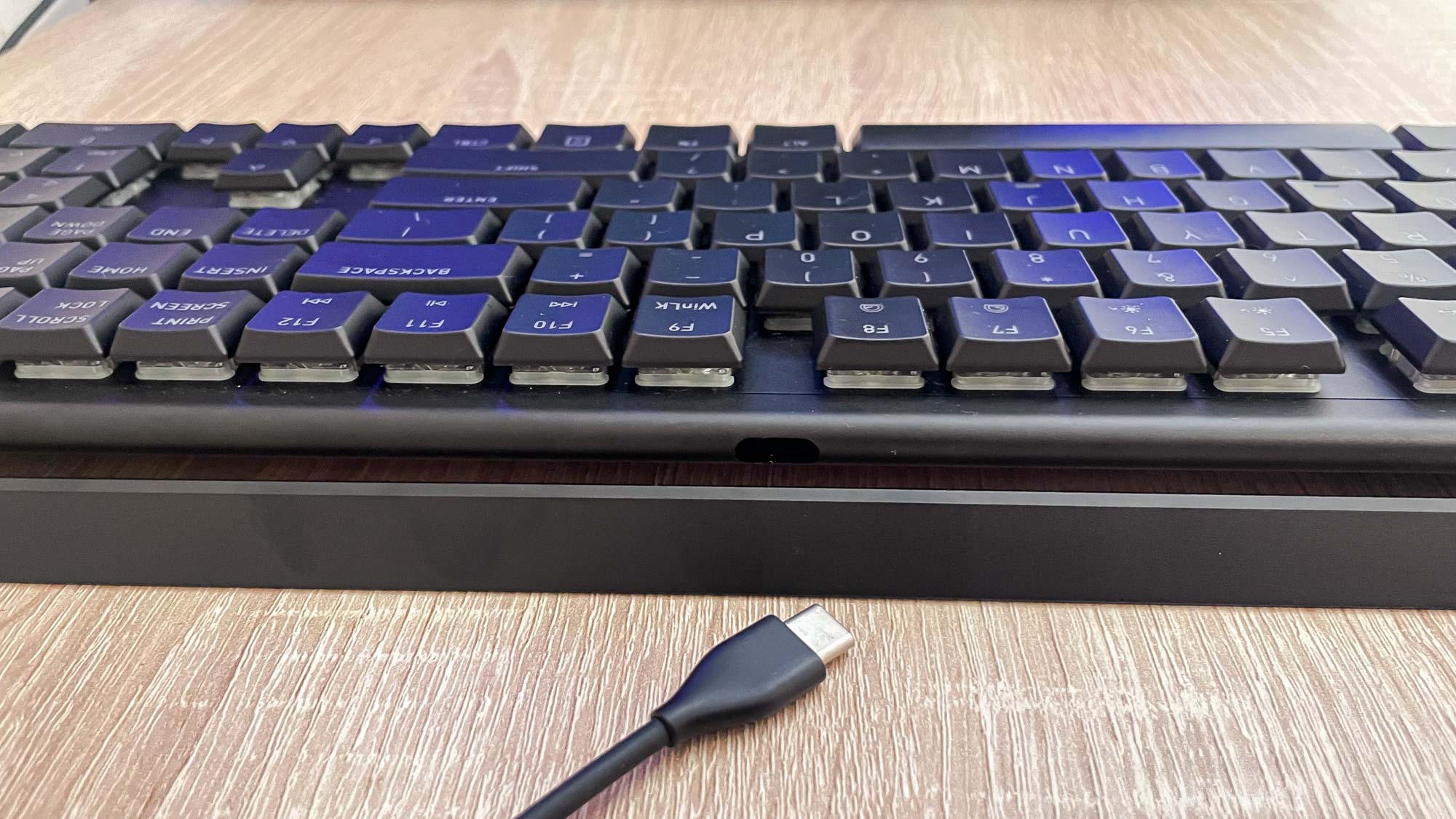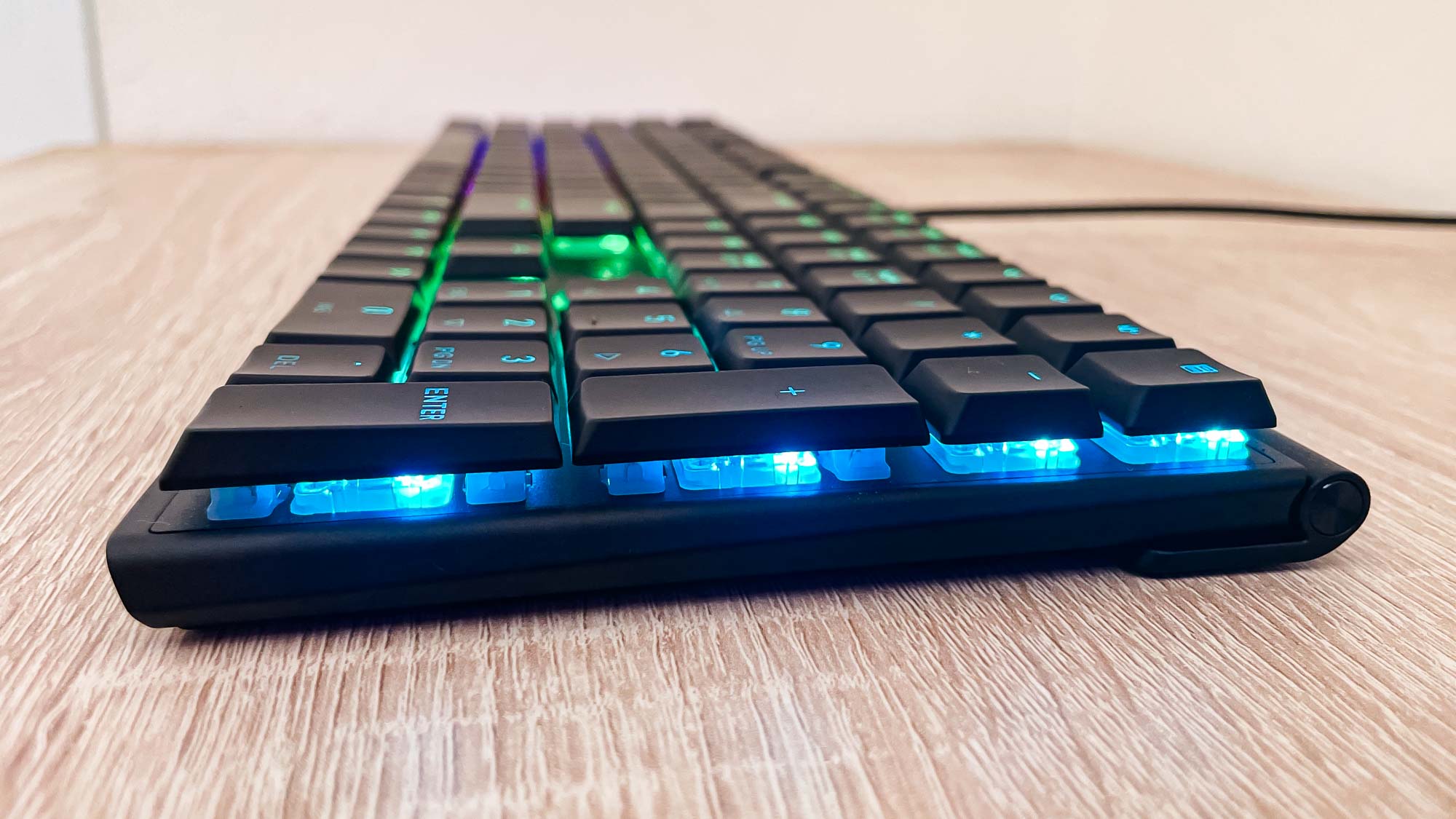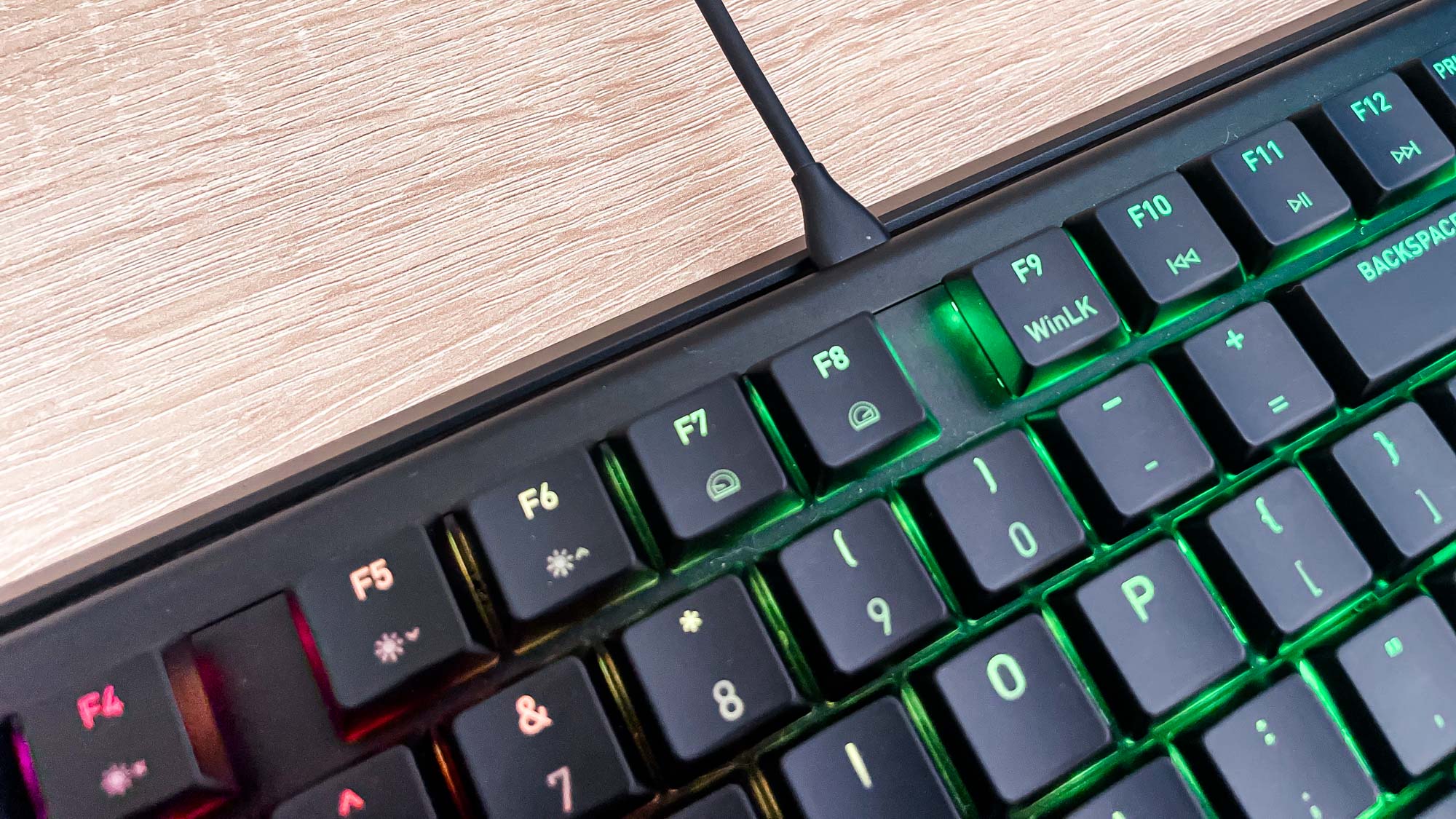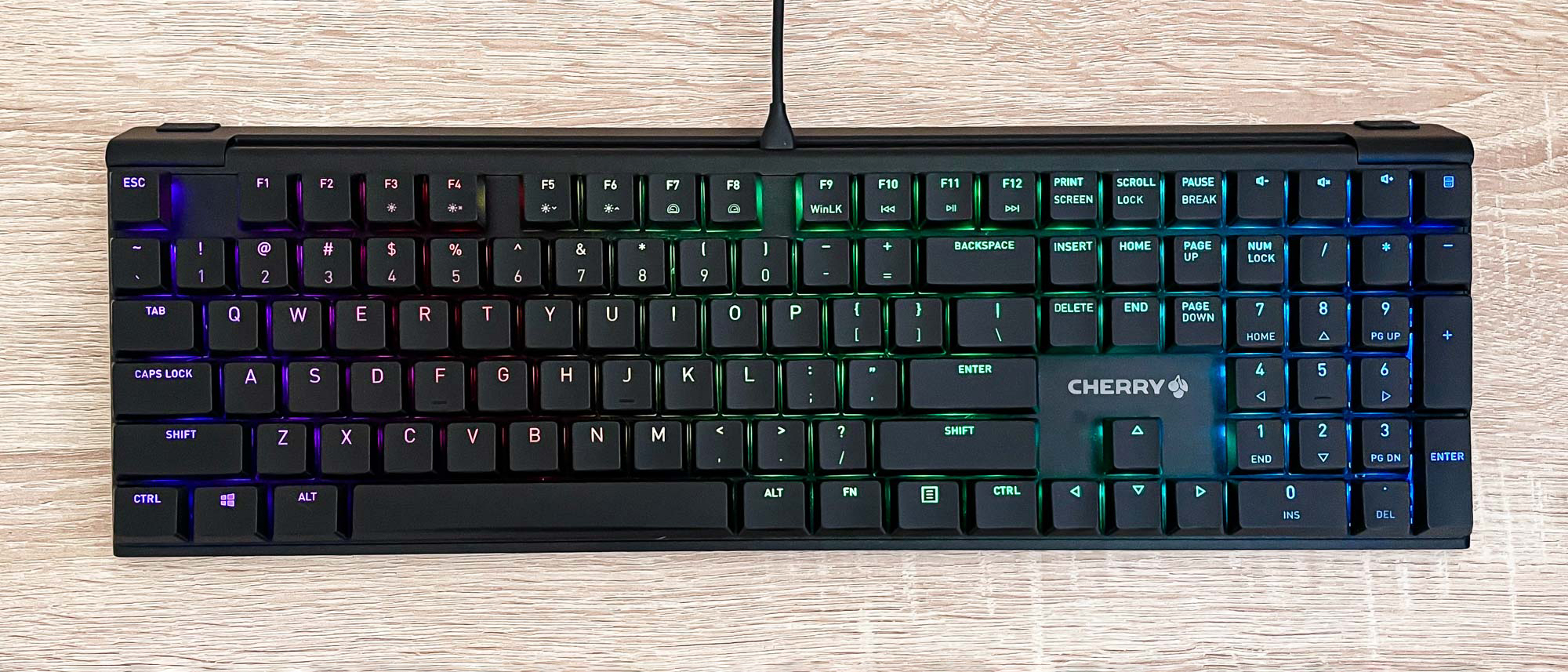Tom's Guide Verdict
The Cherry MX 10.0N RGB is a premium mechanical keyboard with low-profile linear switches that help it stay remarkably thin. If that's the kind of keyboard you crave, this is a great option that's worth the price.
Pros
- +
Slim, sturdy all-metal chassis travels well
- +
Cherry MX Low Profile switches feel good to type on
- +
Excellent RGB customization features
Cons
- -
Low profile can be uncomfortable for big hands
Why you can trust Tom's Guide
Price: $159
Switches: Cherry MX Low Profile RGB Speed switches
Layout: Full size
Operating system: Windows 7 - 11
Backlighting: RGB
Measurements: approx. 16.7 x 5 x 0.86 inches
Weight: 1.8 pounds
The Cherry MX 10.0N RGB ($159) is a mechanical keyboard for those who prefer to keep a low profile. It's thinner than most, with an all-black aluminum chassis that would look right at home in a modern office setting.
Fire up the per-key RGB underlighting, however, and the Cherry MX 10.0N RGB starts to look a lot more like what it is: a premium mechanical keyboard well-suited to marathon sessions of typing or gaming.
With features like low-profile Cherry MX switches, anti-ghosting and N-key rollover, this is one of the best mechanical keyboards you can buy right now. However, there are some potential downsides to this keyboard that you should know about if you're considering buying one. Read on for our full review!
Cherry MX 10.0N RGB review: Price and availability
The Cherry MX 10.0N RGB is available for sale right now via Amazon, Newegg and other third-party retailers.

It costs $159, though the price fluctuates at places like Newegg and you can often get it on sale for a decent discount.
Cherry MX 10.0N RGB review: Design
The Cherry MX 10.0N RGB mechanical keyboard weighs just under 2 pounds and is less than an inch tall, making it one of the more portable full-size options on our list of the best gaming keyboards you can buy. The all-black chassis is aluminum, and feels nice and sturdy under your hands. In the many weeks I spent typing and gaming on this board, I never once felt a hint of it flexing or bending under my hands.
That's notable because my mitts are on the larger end, as human hands go, and I often feel keyboards give or move a bit when I really get going and the WPM starts to climb. Not so with the Cherry MX 10.0N RGB; while this keyboard definitely feels light and easy to move, under pressure it's a very sturdy piece of kit.
Get instant access to breaking news, the hottest reviews, great deals and helpful tips.

Along the rear of the keyboard is a slim stand, also of black aluminum, that folds out and down when you lift the keyboard up. This lets you change the angle you're typing at, raising the rear of the keyboard up off the desk a smidge or lowering it down to lay flat based on your preference. It's nice to have, and easy to ignore if you don't like using it.
Similarly nice to have is the removable USB-C to USB-A cable which comes with the keyboard. The USB-C end plugs into the keyboard while the USB-A end goes to your PC (so you'll need an adapter if you don't have any free USB-A ports), and the cable can be detached from both and packed up for easier travel.
Cherry MX 10.0N RGB review: Keys
The Cherry MX 10.0N RGB comes with Cherry MX Low Profile RGB Speed key switches, which sit lower to the keyboard than any I've ever used. This is one of this board's defining features, and it's a real love-it-or-hate-it design choice. Personally, I don't think I like it.
That's not to say it's a bad keyboard; to the contrary, the low-slung keys feel very nice to type on, and the laser-etched lettering looks sharp. The linear switch activates after just a millimeter or so of travel, and since it's not clicky this can be quite a quiet set of keys -- if you're a light typist. If you're a ham-fisted key-pounder like me, however, expect to hear a pleasant clatter whenever you bottom out.

The keys can be dressed up or down to suit the setting using the board's excellent customizable RGB lighting (more on that later), and the whole device feels like a well-designed, premium keyboard. As small as it is, it's not hard to see where the money's going on something like this: quality.
But after weeks of use, my hands ached for the extra travel of a larger, taller board like the Corsair K70 RGB Mk.2, our current top mechanical keyboard recommendation. I mention this in part because Cherry advertises the slim design as an ergonomic feature, enabling you to "type ergonomically and comfortably even without a palm rest."
I recommend you consult a professional to determine whether you should type without a palm rest on this keyboard or any keyboard, and note the measurements of this board carefully to determine whether the slim profile is for you. It may feel comfortable and ergonomic for some, but personally I found the low-profile keys made my long fingers feel cramped and unhappy after sessions on this keyboard. My typing speed suffered too, and I dropped down to an average 76 words per minute when I usually hover around the 95-110 WPM range.
Regardless, it's an elegant, well-made device. If you like the idea of a low-profile linear mechanical keyboard, this is a great one.
Cherry MX 10.0N RGB review: Features
The Cherry MX 10.0N RGB offers n-key rollover and anti-ghosting that work well, in my experience. I spent hours playing games like Apex Legends on this keyboard, and never noticed any misread or missed inputs.

A few of the MX 10.0N RGB's features make it especially well-suited to travel. First and foremost, it has a low-profile USB cable that disconnects at both ends for easy storage. Plus, the 8 MB of onboard memory allows the board to remember settings even when it's unplugged, which is a welcome touch.
You can also use the function keys on the keyboard to switch between a series of preset RGB lighting modes without needing to download the Cherry Keys RGB control software, which is handy. If you do download the software and play around with it, you can customize the board's lighting scheme to a pretty fine degree, allowing for some fun timing and effect tricks.
Cherry MX 10.0N RGB review: Verdict
The Cherry MX 10.0N RGB is a premium low-profile mechanical keyboard that's equally well-suited for work or play. It feels sturdy and nice to type on, with an elegant matte black metal chassis that looks equally at home in an office or next to one of the best gaming PCs on the market.
The $159 asking price is competitive for a mechanical keyboard of this quality, so the only real dealbreaker here is whether or not you like the idea of typing on low-profile linear switches. Compare the measurements of the MX 10.0N RGB to whatever keyboard you're using now, and think about whether keys that are less than 1 inch tall would feel nice under your fingers. I recommend you consult an ergonomics expert, because everyone's needs are different.
Personally, I prefer the taller keys and deeper travel of a keyboard like the $180 Corsair K70 RGB Mk.2. The remarkably expensive Logitech G915 ($250) is also an excellent alternative that's nearly as thin as the MX 10.0N RGB, and wireless. However, those in the market for a low-profile mechanical keyboard will be well-served by the excellent Cherry MX 10.0N RGB.

Alex Wawro is a lifelong tech and games enthusiast with more than a decade of experience covering both for outlets like Game Developer, Black Hat, and PC World magazine. A lifelong PC builder, he currently serves as a senior editor at Tom's Guide covering all things computing, from laptops and desktops to keyboards and mice.

